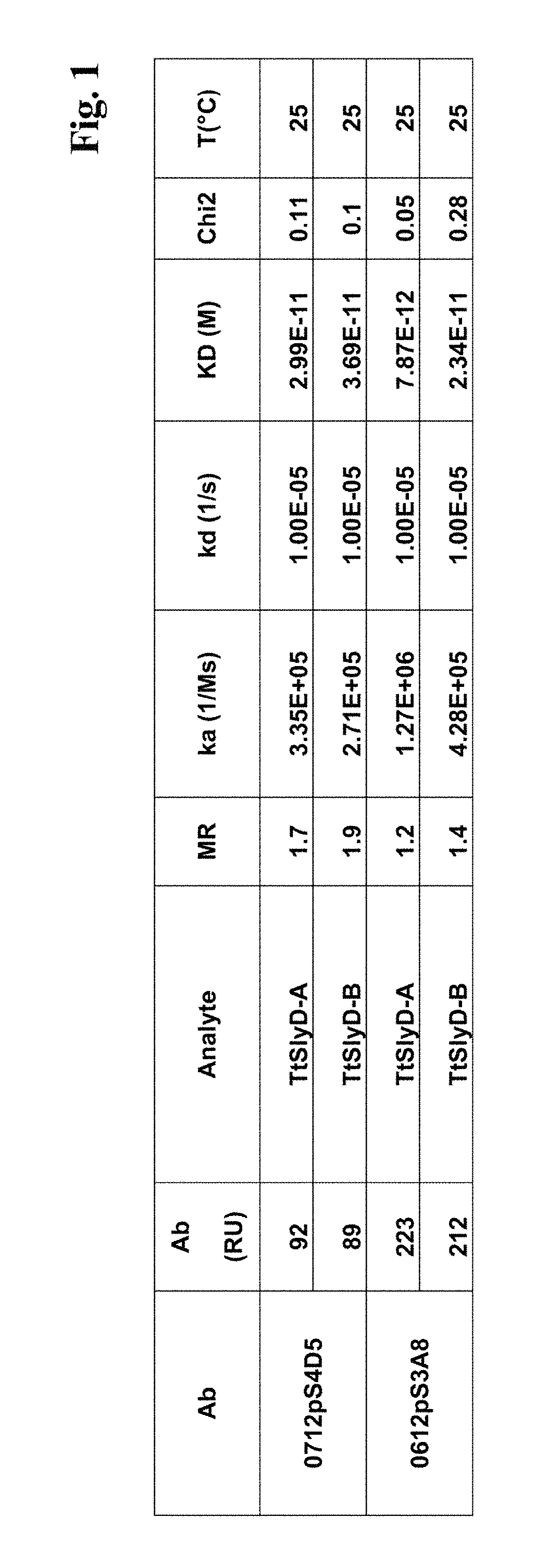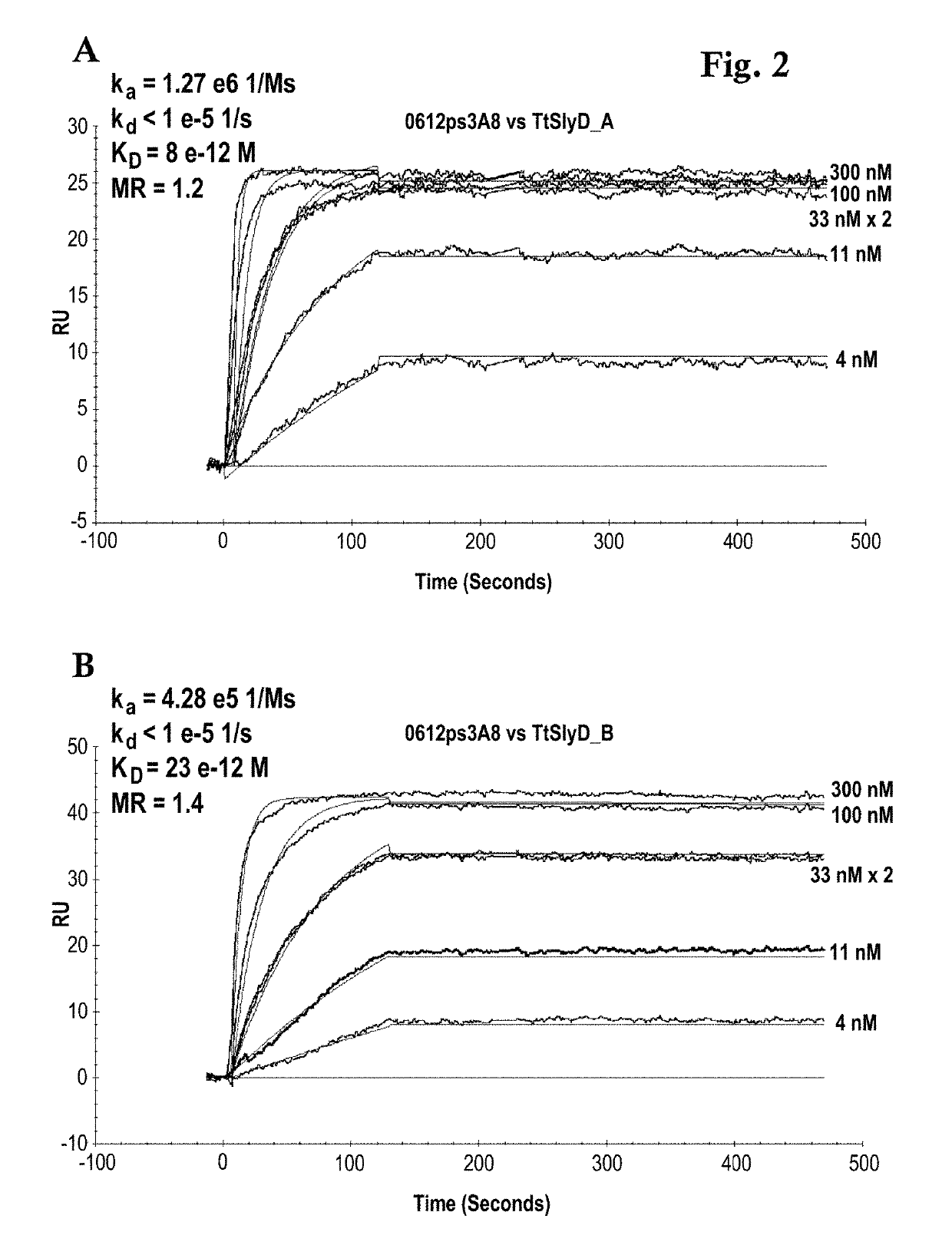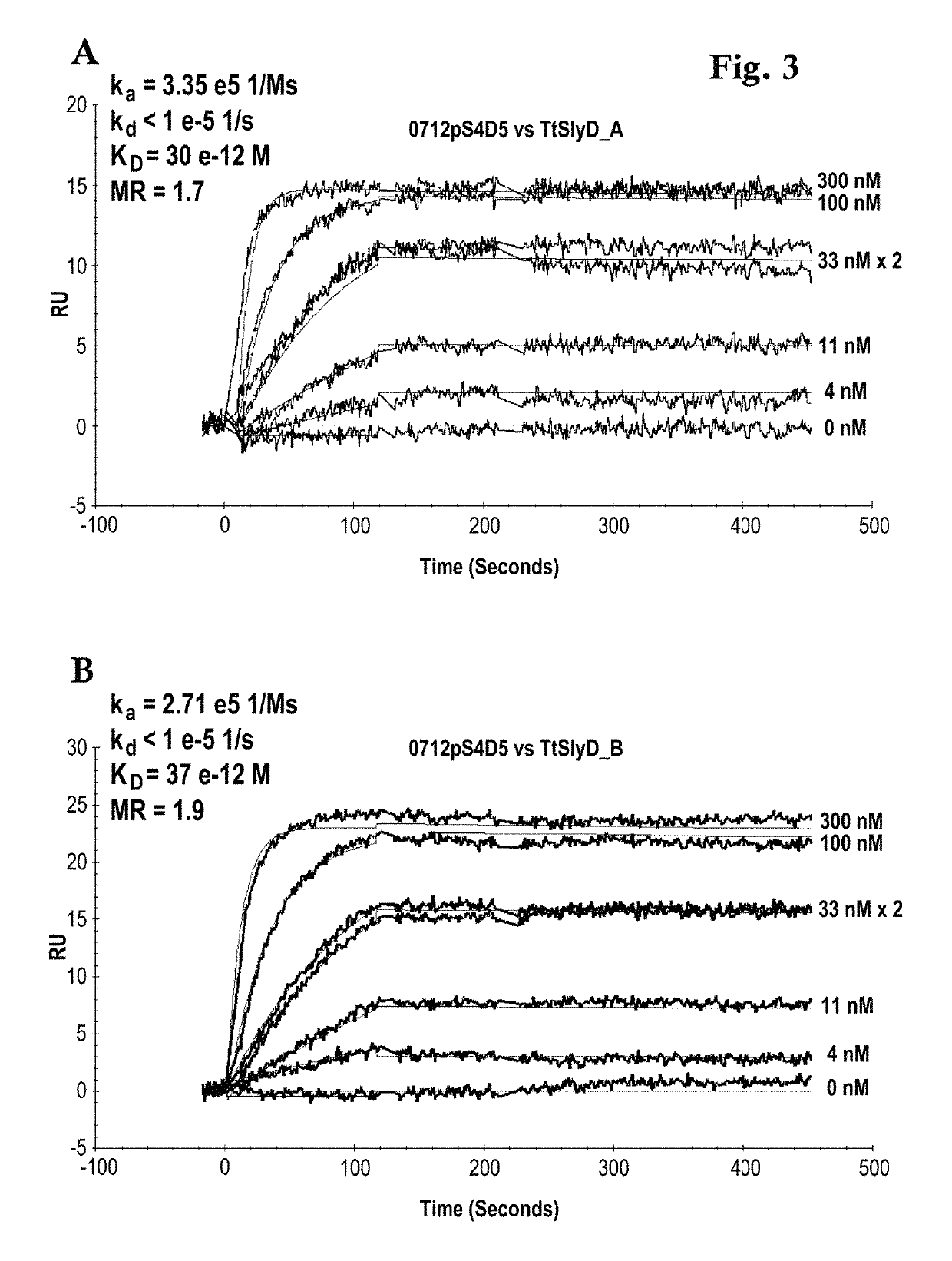Thermus thermophilus SlyD FKBP domain specific antibodies
a technology of thermophilus and specific antibodies, applied in the field of antithermus thermophilus slyd fkbp domain antibodies, can solve the problem of the intrinsic flexibility of linear polypeptides comprising about 5 to about 50 amino acids
- Summary
- Abstract
- Description
- Claims
- Application Information
AI Technical Summary
Benefits of technology
Problems solved by technology
Method used
Image
Examples
example 1
Anti-TtSlyD-FKBP Antibody Development with Rabbit B-Cell PCR
[0161]For the generation of antibodies against TtSlyD-FKBP, 16-week old ZiKa rabbits were immunized with native TtSlyD-FKBP. All rabbits were subjected to repeated immunizations. In the first months the animals were immunized weekly. From the second month onward the animals were immunized once per month. For each immunization 100 μg TtSlyD-FKBP dissolved in 1 ml 140 mM NaCl was emulsified in 1 ml CFA. The development of titers was evaluated on days 45 and 105 after the first immunization. When titers against the immunogen were detected antibodies were developed by B-cell cloning as described in Ligthwood et al. 2006, Journal of Immunological Methods 316, 133-143. Recombinant rabbit IgG was expressed by transient transfection of HEK293 cells. For the determination of the serum titers against TtSlyD-FKBP a small amount of serum of each rabbit was collected on day 45 and day 105 after start of the immunization campaign. For th...
example 2
Biacore Binding Affinity
[0162]A Biacore B3000 instrument (GE Healthcare) was mounted with a CM5 research grade sensor and was normalized in HBS-ET buffer (10 mM HEPES pH 7.4, 150 mM NaCl, 3 mM EDTA, 0.005% w / v Tween 20) according to the manufacturer's instructions. The system operated at 25° C. 10000 RU GAR-Fcγ (relative units of Fcγ-fragment binding, polyclonal goat anti-Rabbit IgG / Jackson Laboratories) were immobilized according to the manufacturer's instructions using EDC / NHS chemistry on all 4 flow cells. The sensor is finally deactivated using 1 M ethanolamine. 10 nM of the respective antibody 0712pS4D5 or 0612pS3A8 in system buffer were injected for 2 min at 10 μl / min. TtSlyD-FKBP derivatives were injected at 100 μl / min for 2 min association and 5 min dissociation time in a concentration series of 0 nM, 4 nM, 11 nM, two times 33 nM, 100 nM, 300 nM. The GAR-Fcγ capture system was regenerated by 10 mM glycine pH 1.5 at 20 μl / min for 30 sec, followed by two consecutive injections...
example 3
Biacore Binding Assay
[0163]FIG. 4 shows the instrumental setup of a Biacore SPR binding assay. For such assay, a Biacore B3000 instrument (GE Healthcare) was used to kinetically assess TtSlyD-FKBP derivatives for binding specificity for Taq DNA polymerase A CM5 series sensor was mounted into the system and was normalized in HBS-ET buffer (10 mM HEPES pH 7.4, 150 mM NaCl, 3 mM EDTA, 0.005% w / v Tween 20) according to the manufacturer's instructions. The samples were diluted in the instrument's buffer. The system operated at 25° C. 10000 RU GAR-Fcγ (relative units of Fcγ-fragment binding, polyclonal goat anti-Rabbit IgG / Jackson Laboratories) were immobilized according to the manufacturer's instructions using EDC / NHS chemistry on all 4 flow cells. The sensor was finally deactivated using 1 M ethanolamine.
[0164]The binding activity of the TtSlyD-FKBP clones 3 F12, 5F8 and 3 C1 versus Taq DNA polymerase was kinetically tested. The monoclonal rabbit anti-TtSlyD-FKBP antibody (0612pS3A8), w...
PUM
| Property | Measurement | Unit |
|---|---|---|
| dissociation constant | aaaaa | aaaaa |
| dissociation constant | aaaaa | aaaaa |
| dissociation constant | aaaaa | aaaaa |
Abstract
Description
Claims
Application Information
 Login to View More
Login to View More - R&D
- Intellectual Property
- Life Sciences
- Materials
- Tech Scout
- Unparalleled Data Quality
- Higher Quality Content
- 60% Fewer Hallucinations
Browse by: Latest US Patents, China's latest patents, Technical Efficacy Thesaurus, Application Domain, Technology Topic, Popular Technical Reports.
© 2025 PatSnap. All rights reserved.Legal|Privacy policy|Modern Slavery Act Transparency Statement|Sitemap|About US| Contact US: help@patsnap.com



